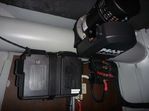Popular belief
How does it work?
A bow thruster consists of a propeller installed below the waterline close to the bow. Driven by a powerful electric motor, the propeller, operated from the helm, often by a joystick, direct the bow left or right. Working in connection with the main engine, the bow thrusters facilitates port manoeuvres. To be effective the propeller of the thrusters must be placed as far forward as possible (to provide the best leverage) but sufficiently submerged to ensure propulsion and not simply disturb the air. This is the paradox because on sailing vessels as on motor launches, the forward section of the hull is often low to the water. The positioning of the propeller is thus, a compromise. Certain models of thrusters may be installed to the rear of the boat. These are called the stern thrusters. Bow and stern thrusters combined can move the boat laterally.
Retractable or tunnel?
-Retractable: By retracting into the hull, the thruster propeller disappears entirely. This has the advantage of not disturbing the water when sailing. In operating position, the thruster propeller gains in depth, an advantage for the correct operation of the thruster. Thus, a retractable thruster may be positioned well to the front of the boat and its own propeller, when in the down position, substantially at the same depth as the boat propeller, its efficiency is maximal. However, the installation is delicate and bulky inside the boat. Besides the mechanical input / output, an immersed mechanism, will always remain a weak link.
- Tunnel: the tunnel thruster is easier to install. The negative points are that it cannot be mounted too flat on the boat’s hull and too be as efficient as the retractable, one must take a higher powered model (the propeller inside the tunnel is less powerful.)

- Tunnel: the tunnel thruster is easier to install. The negative points are that it cannot be mounted too flat on the boat’s hull and too be as efficient as the retractable, one must take a higher powered model (the propeller inside the tunnel is less powerful.)

Calculating the power
For the power calculation, a formula which takes into account wind pressure and the surface of the boat exposed to the wind, permits the calculating the torque and the optimal power required for the thruster. One arrives, through this formula, for a 12m boat with a lateral wind of force 4, a thruster power of 30kg and a force of 6, 84kg. In practice, it is necessary to average these two values; we thus reach from 60 to 70 kg. Refer to the manufacturers own thruster tables or seek information at your AD store to find the model suited to your boat.
Service
Fitting, a delicate operation
From the choice of model to its installation onboard, AD technicians after a series of tests and calculations will identify all your thruster needs, whether they are bow or stern. They will ensure complete optimisation of your boat’s capacity while reducing any loss of power! Cable length calculations, hull piercing, finishing….you can trust AD technicians!
Fitting, a delicate operation
From the choice of model to its installation onboard, AD technicians after a series of tests and calculations will identify all your thruster needs, whether they are bow or stern. They will ensure complete optimisation of your boat’s capacity while reducing any loss of power! Cable length calculations, hull piercing, finishing….you can trust AD technicians!
Installation
Whatever the thruster; tunnel or retractable, it needs to work on the structure of the boat. An error of positioning can have serious consequences. If you envisage doing it yourself, only an expert is able to provide all the necessary advice. A thruster is a major electrical consumer (motor from 2000 to 4000 watts.) It is imperative to take cables dimensioned accordingly. To reduce their diameter, it is common to install the battery near the thruster. We recommend a battery that accepts high currents (eg Optima starter battery.) The operating time is very short, the current taken from the battery is minimal.


Professional Advice
“To avoid draining the battery and overheating the engine, a propeller must not be used more than one minute without interruption. Use short bursts.”
“To avoid draining the battery and overheating the engine, a propeller must not be used more than one minute without interruption. Use short bursts.”
